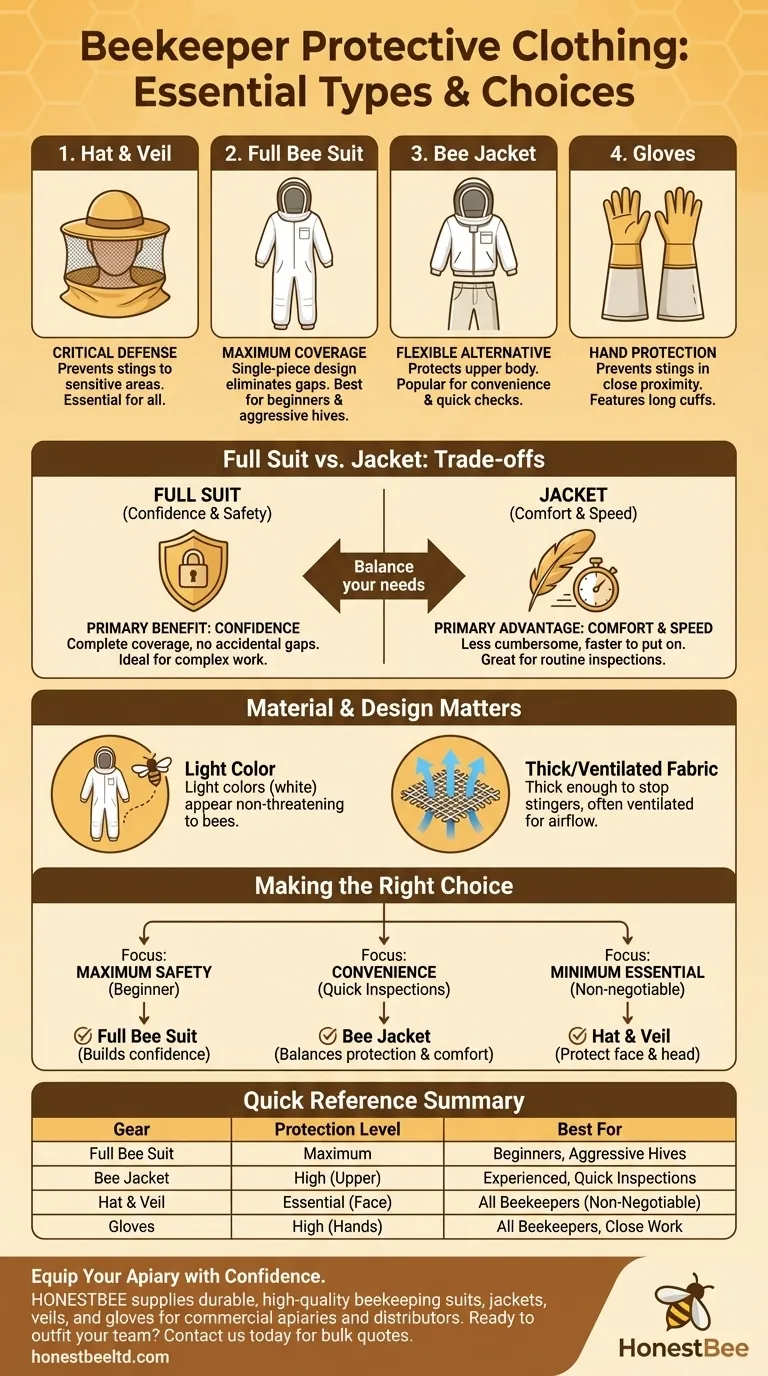The primary types of protective clothing for beekeepers are the full bee suit, the bee jacket, the hat and veil, and gloves. These components are often used in different combinations to provide varying levels of protection against stings, allowing beekeepers to choose their gear based on the task, hive temperament, and personal comfort.
The choice of beekeeping gear is fundamentally a balance between comprehensive protection and practical comfort. While a full suit offers maximum security, the non-negotiable core of any setup is the hat and veil, which protects the most vulnerable areas of your head and face.

The Essential Components of Beekeeper Protection
Understanding each piece of equipment is crucial for assembling a kit that fits your needs. The goal is to create a secure barrier that prevents bees from reaching your skin.
The Veil and Hat: Your First Line of Defense
The hat and veil combination is the most critical piece of protective gear. Stings to the face, particularly around the eyes, nose, and mouth, are uniquely painful and dangerous.
This essential item keeps bees away from your head while providing necessary visibility to work safely and effectively within the hive.
The Full Bee Suit: Maximum Coverage
A full bee suit is a single-piece coverall, often with an integrated veil, that provides head-to-ankle protection. It is the most secure option available.
By eliminating the gap between a jacket and pants, it offers the best defense against determined bees. This makes it the preferred choice for beginners or when dealing with a particularly aggressive hive.
The Bee Jacket: A Flexible Alternative
A bee jacket offers protection for the upper body and is typically paired with thick, durable pants like jeans or cotton scrubs. Most jackets also come with a built-in veil.
This setup is popular among experienced beekeepers for its convenience. It is easier to put on for quick hive inspections and can be cooler in warm climates.
Beekeeping Gloves: Protecting Your Hands
Beekeeping gloves are designed to prevent stings on the hands, which are in closest proximity to the bees during inspections.
They are typically made from leather or other thick materials and often feature long gauntlets that extend over the wrists and sleeve cuffs, closing another potential entry point for bees.
Understanding the Trade-offs
Choosing between a full suit and a jacket is one of the first major decisions a new beekeeper makes. There is no single correct answer, only what is right for your situation.
The Case for the Full Suit
The primary benefit of a full suit is confidence. Knowing you are completely covered allows you to move calmly and deliberately, which is less likely to agitate the bees.
Its one-piece design ensures there are no accidental gaps where a bee could crawl in, providing peace of mind, especially during lengthy or complex hive work.
The Case for the Jacket
A jacket's main advantages are comfort and speed. It is less cumbersome than a full suit and significantly faster to put on and take off.
For experienced beekeepers performing routine checks, the convenience of a jacket often outweighs the absolute protection of a full suit.
The Importance of Color and Material
You will notice that virtually all beekeeping gear is light-colored, typically white. This is because dark colors can appear threatening to bees, resembling natural predators like bears.
The material should be thick enough to prevent a bee's stinger from reaching your skin. Many modern suits and jackets use layered mesh or ventilated fabrics to improve airflow without sacrificing protection.
Making the Right Choice for Your Goal
Your choice of protective gear should be based on your experience level, the temperament of your bees, and your personal comfort with risk.
- If your primary focus is maximum safety as a beginner: A full bee suit is the unambiguous choice to build confidence and ensure complete protection.
- If your primary focus is convenience for quick inspections: A bee jacket paired with durable, light-colored pants provides an excellent balance of protection and comfort.
- If your primary focus is the absolute minimum for safety: Never work a hive without a quality hat and veil to protect your face and head.
Ultimately, the right protective clothing is the gear that allows you to work with your bees calmly, confidently, and safely.
Summary Table:
| Protective Gear | Protection Level | Best For |
|---|---|---|
| Full Bee Suit | Maximum (Head-to-Toe) | Beginners, Aggressive Hives |
| Bee Jacket | High (Upper Body) | Experienced Beekeepers, Quick Inspections |
| Hat & Veil | Essential (Face/Head) | All Beekeepers, Non-Negotiable Safety |
| Gloves | High (Hands/Wrists) | All Beekeepers, Close Hive Work |
Equip Your Apiary with Confidence
Choosing the right protective gear is the first step to safe and productive beekeeping. HONESTBEE supplies durable, high-quality beekeeping suits, jackets, veils, and gloves designed for the demands of commercial apiaries and distributors.
We understand that your safety and efficiency are paramount. Our wholesale-focused operations ensure you get the reliable equipment you need.
Ready to outfit your team? Contact HONESTBEE today to discuss your bulk equipment needs and get a quote.
Visual Guide

Related Products
- White Beekeeping Protective Suit and Hat with Fencing Veil for Beekeepers
- Cotton Beekeeping Suit and Round Hat with Veil Bee Keeper Protective Gear
- Beekeeping Jacket with Hood and Veil for Beekeepers
- Economy Polyester Beekeeping Jacket with Veil and Hat
- Heavy Duty Cowboy Beekeeper Hat with Visibility Veil Outdoor Professional Beekeeping Protective Gear
People Also Ask
- What are the essential components of a beekeeper's attire? Build Your Complete Protective System
- How do beekeepers not get stung? Master Bee Behavior & Protective Gear
- How should beekeeping attire be maintained? Extend Gear Life & Maximize Protection
- Why is it important to choose protective clothing with some freedom to move around? For Unrestricted Safety & Efficiency
- What are the common types of protective clothing used in beekeeping? Stay Safe and Confident at the Hive



















